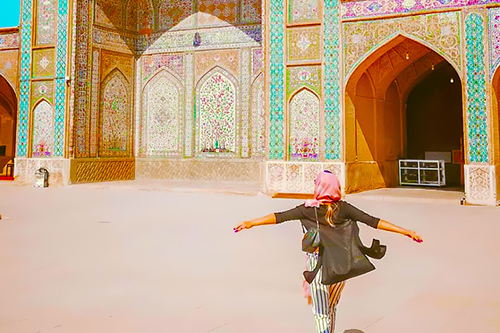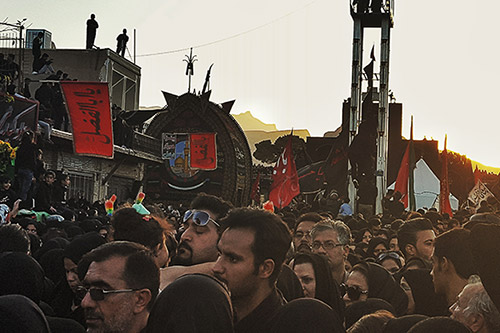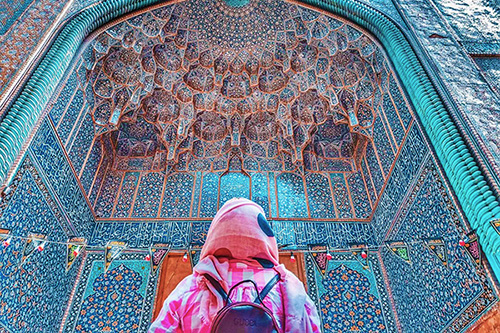 Signin with Google
Signin with Google Signin with Facebook
Signin with Facebook About Iran
About IranHistory of Iran at a Glance

Going into the details of the history of Iran would take a long time, as it is one of the oldest civilizations in the world, which has seen the rise of some of the most powerful empires. However, for any visitors coming to Iran, it is important to get a little bit familiar with its history, to be able to appreciate its historical sites and its rich culture. So, here is a brief history of Iran, from ancient civilizations to the first Persian Empires and the Islamic Republic of Iran.
PART 1: Ancient pre-Iranian civilizations
1. The Pro-Elamites and Elamite civilization (3100 BC - 640 BC)
The Elamite civilization marks the beginning of the cultural history of Iran. This ancient pre-Iranian civilization occupied parts of southern Iran and founded its capital in the city of Susa (Shush). For a long time under Mesopotamian domination, the Elamites progressively adopted their language, the cuneiform writing, as well as their gods and temple. The construction of Choqa Zanbil, a massive ziggurat that remains one of the best-preserved in the world, shows the peak of this important civilization, which disappeared with the Assyrian invasion.
2. The Medes (678 - 549 BC)
The wave of Indo-European immigration is at the origin of the first Iranian peoples, the Medes and the Persians. Settled in today's Kurdistan, the Medes were pastoral tribes who got united against the Assyrians. They built a rich and vast empire and called their land "Iran", literally "home of Aryans". At that time, the main religions were Mithraism and Zoroastrianism.
PART 2: The rise of Persian Empires
1. The Achaemenid Empire (550 – 330 BC)
The Achaemenid Empire is probably the greatest Persian Empire, one of the largest in history, which at its culmination went from the Aegean Sea to the Indus. By uniting the Medes and Persians, Cyrus the Great formed the first Persian Empire. He built his capital in Pasagardea, in Fars Province, the heart of the Empire. Thanks to Cyrus the Great, the Achaemenid Empire was a multicultural empire and a tolerant society, uniting 20 different ethnic groups, with their own culture, language, and religion. However, the main religion at that time was Zoroastrianism. Darius the Great gain access to the throne in 522 BC and built its palace in Susa and Persepolis. Several kings succeed him until the last Achaemenid king, Darius III, was defeated by Alexander the Great.
2. From Alexander the Great to the Sassanians (330 BC - 224 BC)
The Macedonian king took one by one the Achaemenids cities, from Susa to Babylon, and Persepolis which he ordered to burn down in 330 BC. When Darius III was assassinated, he proclaimed himself king of the Persian Empire and died less than 10 years later in Babylon. For more than 40 years, its territory was torn apart by wars for the succession. Eventually, it was divided into three parts: Macedonia, Egypt, and Asia. This later was attributed to the Seleucid Empire, which reigned for about 50 years before the Parthian Empire, whose reign only lasted a bit more than 20 years.
3. The Sassanian Empire (224 BC - 651)
The Sassanian Empire is the last pre-Islamic Persian Empire, under which Persian culture and traditions flourished. It was one of the world's strongest Empires at that time along with the Roman-Byzantine Empire. Its founder, Sassan, was a priest of Anahita Temple in Istakhr (Fars). His grandson, Ardashir I was the first "King of the kings" of the Sassanian Dynasty. Under the reign of the Sassanian Empire, an efficient administration was developed, with centralized power, and important cities were built, while Persian art reaches its peak. By the end of the Sassanian era, the Empire was weakened over 40 years by revolutions and famines, before the reign of Khosrow I, who bring back stability. His descendant Khosrow II remained famous for its rightfulness and his love story with Shirin which has created one of the most romantic stories of Persian literature. His assassination marked the end of the Persian Empires.
PART 3: The Muslim conquest
1. The Umayyad Caliphate (661–750)
After the death of the Prophet Muhammad started the Muslim conquests and the Arabs quickly defeated the Persians in 637. They conquered a huge territory and also converted inhabitants to a new religion, Islam. The Umayyad gave birth to the first Muslim civilization, however, the transformation of Iran was hard to achieve due to the resistance of the population, especially in the Caspian Sea region. If Sunni Islam was eventually adopted by a vast majority of the population, the pre-Islamic Persian culture subsisted. The Abbasid Caliphate succeeded the Umayyad in 750. They adopted most of the Persian customs and participated in the development of arts and literature. Several empires succeeded to each over 300 years, including the Seljuk Empire, a Turco-Persian Dynasty which established several religious schools (madrassas), built Persian mosques, and adopted Persian as their official language.
2. The Mongols invasions (1194 – 1501)
After the fall of the Seljuk Empire, the Khwarezmid Empire, one of the largest Muslim realms, reigned over Persia. With the assassination of one of Genghis Khan Emissaries, the Mongol ruler sent his troops to devastate Central Asia and submit Persia. The Mongol Empire of the Ilkhanids was established in 1215. Their era is remembered for their cruelty, destroying many villages and killing thousands of inhabitants. However, this large empire has contributed to the diffusion of Islam up to China. They also deeply influenced Persian arts such as decorative arts, carpets, and miniature. The Ilkhanid Empire was replaced by the reign of Tamerlane and the Timurids for more than a century until the advent of the Safavid Empire.
PART 4: The Safavid Empire and the rebirth of Persian Empires
1. The Safavid Empire (1501 – 1722)
The Safavid Empire is considered one of the greatest Persian Empires and marks the beginning of the modern history of Iran. Originating from the Azerbaijan Province, its founder was Shah Ismael I. His ancestor, Sheikh Safi al-Din, was an important Sufi figure, buried in the shrine of Ardabil. With the Safavid Empire, the realm accessed for the first time to political autonomy. They established Shia as the official religion and, thus, gave the country a distinct identity from the Arabs neighbouring countries, which remained Sunni. Shah Abbas the Great was seen as one of the greatest Persian rulers, capable of giving back the ancient glory of the empire. He established a central power, along with religious freedom, and the development of commerce. However, by assassinating several of his sons and grandsons he neglected his succession and left its empire between the hands of corrupted civil servants.
2. From Nader Shah to Karim Khan (1722 – 1794)
Affected economically and ethically, the country slowly declined. The Afghans ended up the reign of the Safavids in 1722, before being deposed by Nader Shah, who founded the Afsharid Dynasty. At his death, the country fell into civil war, ended up by the reign of Karim Khan, founder of the Zand Dynasty. He established his capital in Shiraz and led a peaceful and enlightened regime. With his death, a civil war started over again and led to the rise of a new dynasty, the Qajar.
PART 5: The Qajar and Pahlavi Empires, the foundation of Modern Iran
1. The Qajar Empire (1779 – 1925)
The Qajar era is a major era of Iran's history, as this dynasty shaped the borders of the country almost as they are today. With the advent of Aqa Muhammad, the first Qajar king, the country found back stability. The new king settled its capital in Tehran and united the country. Under the reign of his grandson, Fath Ali Shah, Persia started to become a battleground between Russia and Great Britain, losing many of its territories, such as Armenia and Afghanistan, in favour of these two powerful countries. Naser al-Din Shah continued to give away the sovereignty of the realm by offering commercial monopolies to the Russians and British, including mines, petrol, and tobacco. This loss of power created a huge dissatisfaction among the population, which protested again the Shah, leading to the Constitutional revolution of 1905. It resulted in the creation of a Parliament, the Majles. During the First World War, Iran stated its neutrality but remained a battlefield for Russia and Great Britain. As a result, at the end of the conflict, Iran was ruined and filled with revolts.
2. The Pahlavi Empire (1925 – 1979)
With the Pahlavi Dynasty, Iran entered into the era of modernity. Its founder, Reza Khan, was the Minister of War of the Qajar and gained power thanks to a coup d'état supported by the British in 1921. He proclaimed himself king and named his dynasty Pahlavi, to refer to the name of the ancestral Middle Persian Language. Reza Shah handled huge reforms to modernize the country, developing industries, railways, non-religious schools but also enforced an authoritarian westernization of the society. In 1935, he officially changed the international name of the country from "Persia" to "Iran". During the Second World War, despite being neutral, the country was invaded by the United Kingdom and Reza Shah capitulated in favour of his son, Mohammad Reza, who became the last king of Iran in 1967.
PART 6: Modern history of Iran
1. The last king of Iran
With Mohammad Reza Pahlavi king of Iran, the country slowly fell under the influence of the United States, while the URSS tried to interfere via the communist party Tudeh. The democratic election of Prime Minister Mohammad Mosaddegh in 1949 marks a turning point in the history of Iran. His decision to nationalize the oil led to a coup d'état orchestrated by the CIA. Mosaddegh is arrested, dismissed, and the Shah, who fled the country, returned to power. In 1961, he started the "White Revolution" to pursue the modernization done by his father, without succeeding to stop corruption and poverty. Disconnected from the reality of people's lives, while forcing westernization, and repressing freedom of speech, he amplified social distress. Protests against the Shah, led by the Mollahs, started to burst in 1978, violently repressed by Mohammad Reza Shah but eventually led to his exile in 1979.
2. The Islamic Republic of Iran (From 1979)
The Islamic Revolution is a major event of the 20th century. Behind it was the Ayatollah Ruhollah Khomeini, an opponent to the Shah. Exiled in 1964, he found refuge in Iraq and then France, near Paris, at Neauphle-le-Château, from where he launched, in 1978, his media campaign. Two weeks after the departure of Mohammad Reza Shah from Iran, Khomeini came back to Tehran, where he was welcomed by thousands of people. The Islamic Republic was proclaimed on the 1st of April 1979. During the first days of the new republic took place a crucial moment of its history with the hostage crisis of the American Embassy, which lasted 444 days. One year later, Iraq's president Saddam Hussein declared war on Iran, opening a conflict that lasted 8 years and killed about 400,000 people, ending up with a ceasefire proclaiming no winner nor changing the frontiers. At the death of Ayatollah Khomeini in 1989, Ayatollah Ali Khamenei became the new Supreme Leader of Iran. Since the advent of the Islamic Republic, Iran has elected seven presidents, the latest being Hassan Rouhani, elected twice in 2013 and 2017.




